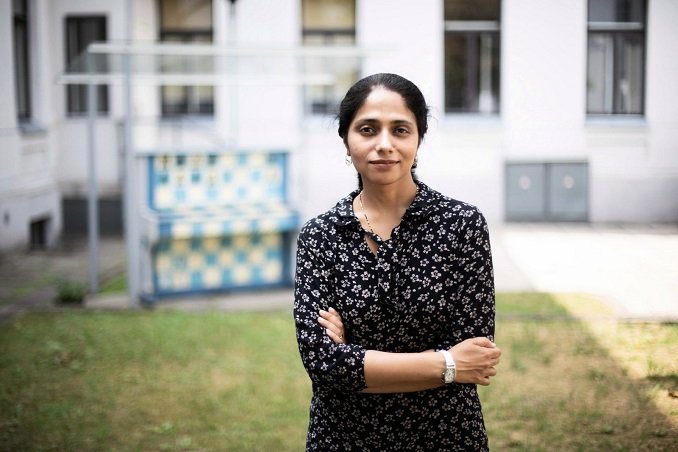
This week, two big celebrations will take place: India will celebrate Holi (also known as Festival of Colour) on 9 and 10 March and the 11th – Lithuania celebrated the 30 years of the Re-Establishment of the State. What is common between the most populous democracy, the 7th largest country in the world with a population of 1,35 billion people and the small Baltic state?
Not only Sanskrit unites us, argues Dr Runa Chakraborty Paunksnis, Head of India Cooperation Development (known as India Centre) at the Kaunas University of Technology (KTU), but also our way of celebrating our festivals.
Dr Runa Chakraborty Paunksnis, Associate Professor at the Faculty of Social Sciences, Arts and Humanities started working at the KTU in 2018. Although she joined the academic community only a couple of years ago, the scholar already feels like a part of the university community. “My position as the Head of India Centre has given me the opportunity to see beyond academic activities of my Faculty and engage with other members of the university,” she said.

Dr Chakraborty Paunksnis thinks that Lithuanian and Indian cultures are not as different as it may seem: “Many scholars have already talked about similarities between Sanskrit and Lithuanian. Personally, I have observed interesting similarities between some Indian and Lithuanian festivals.”
For example, a popular festival Holi (Spring Festival) in India is very similar to Lithuanian Užgavėnės. Holi is also known as the festival of colour since on this occasion people smear each other with different colours. It is celebrated to welcome rejuvenation of new life after the dark days of winter. “I have heard that Lithuanians burn Morė as part of the festival Užgavėnės. During Holi, Indians also burn the effigy of the demon ‘Holika’ to chase away darkness and evil”, the scholar explains.

Indeed, every year Lithuanians too try to get rid of the winter, although this time it was symbolical as it never truly came.
Independence Day is the main event in both countries
The Head of KTU India Centre also finds similarities in the way our two cultures celebrate national holidays: “India celebrates its Independence Day (15 August) with a lot of grandeur. In schools and government institutions, cultural programmes are organised to honour this day. The national flag is hoisted, and national anthem is sung along with other patriotic songs.”
According to Dr Chakraborty Paunksnis, the country also celebrates the Republic Day (26 January) with parades and cultural programmes. On this day in 1950, the Constitution of India came into effect and India was turned into a Republic. Impressive shows revealing India’s rich cultural heritage and diversity are organised by the Central Government as well as State Governments to celebrate this significant occasion.
Naturally, when it comes to commemorating national holidays that have a significant meaning to the state, Lithuania and India, and probably a lot of other countries around the world have a similar understanding: it’s important to pay our respect to the flag and the national anthem. Also, parades with marching bands, free concerts and various cultural events are offered to people on such occasions.
“These celebrations, I think, help people come together and feel a profound sense of unity. They also help people define their national identity and enhance their sense of oneness. No doubt, they contribute to the enrichment of our cultural experience”, says the scholar.
India – unity in diversity
However, Dr Chakraborty Paunksnis notices some cultural differences too: “India is a very diverse country with numerous languages, cultures and climatic conditions. Indians speak different languages in different parts of the country. This is a major dissimilarity, I would say.”
“Likewise, there are various beliefs and cultural practices in India. This diversity is also noticed in people’s food habits. For example, the kind of food found in the northern part of India is very different from the kind of food popular in the southern part. I haven’t come across such diversity in Lithuania, yet,” smiles KTU researcher from India.

While in Lithuania there are four ethnographic regions with their dialects and some area-specific dishes, for example, Samogitian kastinys, the country still is much more homogenous when compared to India.
The importance of cross-cultural communication
Diversity is important for society – in the age of globalisation understanding other cultures from around the world is especially crucial. Dr Chakraborty Paunksnis points out that diversity in university academic life can help students develop multiple perspectives which are necessary for obtaining holistic knowledge. It can also make them more compassionate and tolerant. Moreover, possessing the ability to diversify gives an extra edge in today’s globalised context.
According to the scholar, we should be willing to go beyond our familiar space to have a successful cross-cultural communication: “In most cases, our prejudices or inclination to follow cultural stereotypes hinder us from extending the horizon of our knowledge. Both Lithuania and India possess rich cultural and intellectual resources and can help each other immensely in various fields spanning from science and technology to arts and culture.”
Dr Chakraborty Paunksnis acknowledges that both countries have started taking significant steps to improve the cross-cultural dialogue; however, much more is to be done to forge a stronger relationship.

Be the first to comment